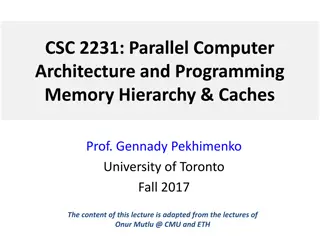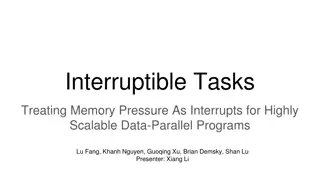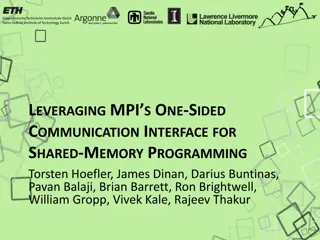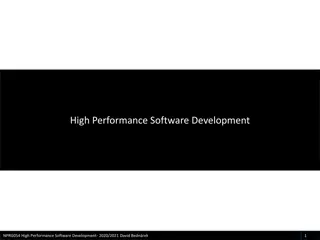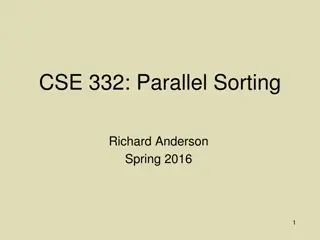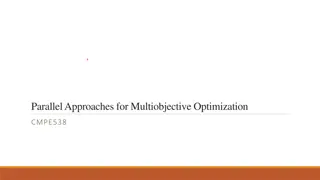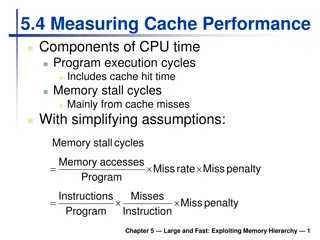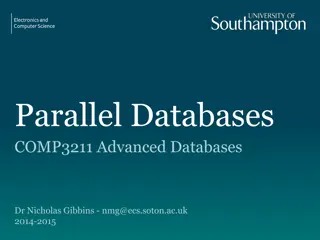Understanding Parallel Programming and Memory Hierarchy in Triton
Explore the concepts of parallel programming, distributed memory, and memory hierarchy in the context of Triton, focusing on technology trends, processor clock speeds, machine architecture, and memory organization at different levels (chip, node, system).
Download Presentation

Please find below an Image/Link to download the presentation.
The content on the website is provided AS IS for your information and personal use only. It may not be sold, licensed, or shared on other websites without obtaining consent from the author. Download presentation by click this link. If you encounter any issues during the download, it is possible that the publisher has removed the file from their server.
E N D
Presentation Transcript
CS 140: Models of parallel programming: Distributed memory and MPI
Technology Trends: Microprocessor Capacity Gordon Moore (Intel co-founder) predicted in 1965 that the transistor density of semiconductor chips would double roughly every 18 months. Moore s Law: # transistors / chip doubles every 1.5 years Microprocessors keep getting smaller, denser, and more powerful.
Trends in processor clock speed Triton s clockspeed is still only 2600 Mhz in 2015!
4-core Intel Sandy Bridge (Triton uses an 8-core version) 2600 Mhz clock speed
Generic Parallel Machine Architecture Storage Hierarchy Proc Cache L2 Cache Proc Cache L2 Cache Proc Cache L2 Cache interconnects potential L3 Cache L3 Cache L3 Cache Memory Memory Memory Key architecture question: Where and how fast are the interconnects? Key algorithm question: Where is the data?
Triton memory hierarchy: I (Chip level) (AMD Opteron 8-core Magny-Cours, similar to Triton s Intel Sandy Bridge) Proc Cache L2 Cache Proc Cache L2 Cache Proc Cache L2 Cache Proc Cache L2 Cache Proc Cache L2 Cache Proc Cache L2 Cache Proc Cache L2 Cache Proc Cache L2 Cache L3 Cache (8MB) Chip sits in socket, connected to the rest of the node . . .
Triton memory hierarchy II (Node level) Node P P P P L1/L2 L1/L2 L1/L2 L1/L2 Chip L3 Cache (20 MB) P P P P L1/L2 L1/L2 L1/L2 L1/L2 P P P P L1/L2 L1/L2 L1/L2 L1/L2 Shared Node Memory (64GB) Chip L3 Cache (20 MB) P P P P L1/L2 L1/L2 L1/L2 L1/L2 <- Infiniband interconnect to other nodes ->
Triton memory hierarchy III (System level) Node Node Node Node Node Node Node Node 64GB 64GB 64GB 64GB 64GB 64GB 64GB 64GB 64GB 64GB 64GB 64GB 64GB 64GB 64GB 64GB Node 324 nodes, message-passing communication, no shared memory Node Node Node Node Node Node Node
Triton memory hierarchy III (System level) Node Node Node Node Node Node Node Node 64GB 64GB 64GB 64GB 64GB 64GB 64GB 64GB 64GB 64GB 64GB 64GB 64GB 64GB 64GB 64GB Node 324 nodes, message-passing communication, no shared memory Node Node Node Node Node Node Node
Some models of parallel computation Computational model Languages Shared memory Cilk, OpenMP, Pthreads SPMD / Message passing MPI SIMD / Data parallel Cuda, Matlab, OpenCL, PGAS / Partitioned global UPC, CAF, Titanium Loosely coupled Map/Reduce, Hadoop, ??? Hybrids
Parallel programming languages Many have been invented *much* less consensus on what are the best languages than in the sequential world. Could have a whole course on them; we ll look just a few. Languages you ll use in homework: C with MPI (very widely used, very old-fashioned) Cilk Plus (a newer upstart) You will choose a language for the final project
Generic Parallel Machine Architecture Storage Hierarchy Proc Cache L2 Cache Proc Cache L2 Cache Proc Cache L2 Cache interconnects potential L3 Cache L3 Cache L3 Cache Memory Memory Memory Key architecture question: Where and how fast are the interconnects? Key algorithm question: Where is the data?
Message-passing programming model P1 NI P0 NI Pn NI memory memory . . . memory interconnect Architecture: Each processor has its own memory and cache but cannot directly access another processor s memory. Language: MPI ( Message-Passing Interface ) A least common denominator based on 1980s technology Links to documentation on course home page SPMD = Single Program, Multiple Data
Hello, world in MPI #include <stdio.h> #include "mpi.h" int main( int argc, char *argv[]) { int rank, size; MPI_Init( &argc, &argv ); MPI_Comm_size( MPI_COMM_WORLD, &size ); MPI_Comm_rank( MPI_COMM_WORLD, &rank ); printf( "Hello world from process %d of %d\n", rank, size ); MPI_Finalize(); return 0; }
MPI in nine routines (all you really need) MPI_Init MPI_Finalize MPI_Comm_size MPI_Comm_rank Initialize Finalize How many processes? Which process am I? MPI_Wtime Timer MPI_Send MPI_Recv Send data to one proc Receive data from one proc MPI_Bcast MPI_Reduce Combine data from all procs Broadcast data to all procs
Ten more MPI routines (sometimes useful) More collective ops (like Bcast and Reduce): MPI_Alltoall, MPI_Alltoallv MPI_Scatter, MPI_Gather Non-blocking send and receive: MPI_Isend, MPI_Irecv MPI_Wait, MPI_Test, MPI_Probe, MPI_Iprobe Synchronization: MPI_Barrier
Example: Send an integer x from proc 0 to proc 1 MPI_Comm_rank(MPI_COMM_WORLD,&myrank); /* get rank */ int msgtag = 1; if (myrank == 0) { int x = 17; MPI_Send(&x, 1, MPI_INT, 1, msgtag, MPI_COMM_WORLD); } else if (myrank == 1) { int x; MPI_Recv(&x, 1, MPI_INT,0,msgtag,MPI_COMM_WORLD,&status); }
Some MPI Concepts Communicator A set of processes that are allowed to communicate among themselves. Kind of like a radio channel . Default communicator: MPI_COMM_WORLD A library can use its own communicator, separated from that of a user program.
Some MPI Concepts Data Type What kind of data is being sent/recvd? Mostly just names for C data types MPI_INT, MPI_CHAR, MPI_DOUBLE, etc.
Some MPI Concepts Message Tag Arbitrary (integer) label for a message Tag of Send must match tag of Recv Useful for error checking & debugging
Parameters of blocking send MPI_Send(buf, count, datatype, dest, tag, comm) Address of send buffer Datatype of each item Message tag Number of items to send Rank of destination process Communicator
Parameters of blocking receive MPI_Recv(buf, count, datatype, src, tag, comm, status) Status after operation Address of receive buffer Message tag Datatype of each item Maximum number of items to receive Rank of source process Communicator
Example: Send an integer x from proc 0 to proc 1 MPI_Comm_rank(MPI_COMM_WORLD,&myrank); /* get rank */ int msgtag = 1; if (myrank == 0) { int x = 17; MPI_Send(&x, 1, MPI_INT, 1, msgtag, MPI_COMM_WORLD); } else if (myrank == 1) { int x; MPI_Recv(&x, 1, MPI_INT,0,msgtag,MPI_COMM_WORLD,&status); }


